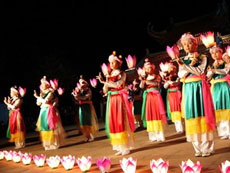Ancient dances, an exceptional art genre that stems from the old capital city of Thang Long, are being revived after a long time in oblivion.

So far no scientific research has been carried out to track down the exact period of time when Hanoi ancient dances were introduced, yet their presence in folk verses, proverbs and ancient bibliographies speaks their age. Images of dance moves are even chosen to be designs and patterns sculptured on bronze drums.
Nguyen Van Bich, President of the Hanoi Dancers’ Association, said Hanoi has nearly 100 ancient dances closely linked with the city’s history that fall into three categories: folk, royal and religious dances.
Some of the dances however have withered under the impacts of time and historical upheavals, Bich said. Only about 30 dances still remain intact, mostly folk dances that usually take place in traditional festivals in villages around Hanoi.
One of the unique dances that is associated with the spirit of Thang Long ancient capital is
chay co from Trieu Khuc Village, Thanh Tri District. The dance is performed in village festivities where amateur artists holding flags, dancing and running in the boisterous sound of drums and castanets. The dance displays the power of solidarity of the Trieu Khuc villagers in their fights against enemies.
Phu Nhieu Village of Phu Xuyen District meanwhile is famous for the
bai bong dance which is a special form of
ca tru. Dancers sport a special hat with a cotton ball glued on top, which explains the name of the dance. In Vietnamese,
bong means cotton and
bai means a way of doing things. While swirling around, dancers continuously unfold two large Chinese-style fans and loudly sing
ca tru melodies. The dance reflects daily life activities of farmers and praises love.
Dancers are backed up with at least eight traditional musical instruments, including two big drums, a
dan day (bottomless lute), a
ty ba (four-string lute), a three-chord lute, a
phach (a bamboo instrument with two wooden stick), a gong and a cylindrical drum. Since setting stage for a
bai bong dance troupe is very expensive, only powerful
giao phuong (large communities of
ca tru performers in each locality) can afford it.
Aside from the above-cited dances, the capital city of Thang Long and Hanoi nowadays are the cradle of various religious dances such as
luc cung, a six floral lamp worship offering, and
bo bo of Dong Anh District, the dragon dance of Phu Dong Village, Gia Lam District, and other districts.
In a wish to preserve this unique cultural trait, the Hanoi Dancers’ Association has cooperated with relevant agencies to implement a project on restoring and promoting ancient dances of Thang Long-Hanoi. Under the project, amateur dancers from villages in Hanoi are getting together to restore ancient dances that have been forgotten and bring them to stage in local communities.
The association will produce audiovisual products and publications about selected ancient and new dances to re-introduce those special dances among the local audience and promote them abroad.
Several dances will be chosen to perform to celebrate the 1,000th anniversary of Thang Long-Hanoi next year, among which the luc cung dance will be performed by Most Venerable Thich Quang Hy, the master of Minh Quang Pagoda in Dong Da District and other monks at the monument of King Ly Thai To.